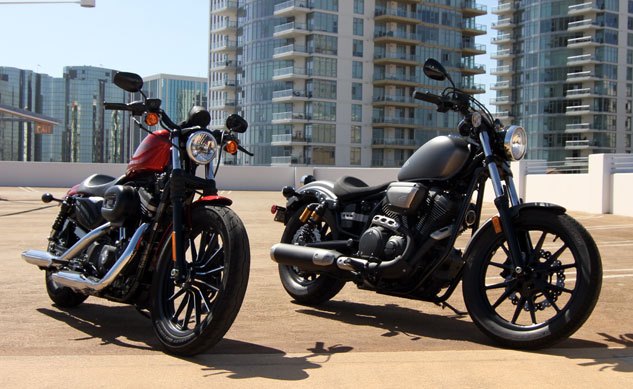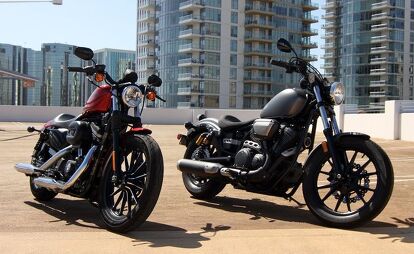2014 Star Bolt Vs. 2013 Harley-Davidson 883 Iron – Video
Star steps up to the plate to challenge the king
If we told you that you could purchase a brand-new urban performance bobber with a blacked out V-Twin engine and components, a stripped neo-industrial appearance and a low seat height that’s ideal for new-ish, female or those “short of leg,” all for under eight grand, would you bite? There are two motorcycle manufacturers producing such a bike. Your choice is between the proven machine with a few well-documented idiosyncrasies, or the upstart contender that’s eager to take on the champ.
Most things being equal – both are stylish, quality-built and cool as all get-out – the obvious deciding factor would be price, right? Sorry, misers, their cost is pretty much equal, too. So how does one decide between the established American legend and the imported arriviste? If you’re on the staff of Motorcycle.com, you ride the hell out of them, and whichever impresses the most, wins.
That’s precisely the thankless task we undertook, when we ran the Harley-Davidson Sportster Iron 883 XL883N and the new Star Bolt up the proverbial flagpole. While the Iron stood its ground, proud and perhaps slightly complacent, the Bolt, which impressed so much on our initial review back in April, worked smarter (not harder), and proved a worthy contender. After a week of boulevard cruises, freeway slogs, dyno runs and twisty tests, the winner is… Well, it depends on whom you ask.
Right off the bat, let’s get this out in the open, because there’s just no sugarcoating it: The 2014 Star Bolt is a shameless rip-off of the Harley Iron 883. Harsh? Hey, the truth stings. From its stripped-down styling to its darkened color scheme, from its muscular profile to its glowering countenance, the Bolt does little to conceal its affinity for the Iron. Heck, it even sports a mono-syllabic, industrial-esque noun for a name. It’s like the Single White Female of bobbers.
The new Bolt is more than just a flattering imitation of the Iron. It’s the latest (and perhaps most brazen) in a decades-long line of bald-faced Asian knockoffs.
That said, Star’s Bolt is more than just the Iron’s creepy stalker. Light, compact and powerful, it’s truly a kick-ass little motorcycle. Better, it benefits from having learned from Harley’s mistakes. From this vantage point, Star has taken the production Urban Bobber concept and produced a more refined package than Harley’s, with more on-road stability and far superior suspension – the Iron’s two infamous liabilities.
The Iron 883 counters simply on the virtue of its badging. It looks, feels, sounds and rides like a Harley, which for many riders is all a bike needs to be judged a superior machine. The Iron and its big brother, the Nightster 1200, were pioneers of the stripped down café/bobber craze so prevalent in the industry these days, so it’s no wonder Star would want a slice of that popular pie; pilfering demographics has been the modus operandi of Japanese OEMs since the ’70s.
One look at the photos demonstrates how similar these bikes are in style, size and purpose. Both are lightweight bobbers, small enough to accommodate most any rider. Both feature sub-1000cc V-Twin engines: the Sportster rocks Harley’s signature 883cc Evo, while the Star uses the identical powerplant found in its V Star 950 cruiser, a 942cc 60-degree V-Twin. The Bolt is a slightly larger bike (and rides like it), with a wider fuel tank and an overall length of 90.2 inches versus the Iron’s 85.8, but the Bolt has a 2-inch shorter wheelbase.
The Iron is 25 pounds heavier, with a curb weight of 565 pounds as opposed to the Bolt’s 540, and it carries its weight lower, with a seat height of 26.9 inches and a ground clearance of 3.9 inches. Meanwhile the Bolt carries its rider at 27.2 inches and sits 5.1 inches off the pavement. Both bikes sport black spoke wheels, the Harley using 13-spoke jobs while the Star makes do with 12. And both motorcycles feature 100/90-19 tires in the front and 150/80-16 hoops in the back.
Around town, both bikes handle nimbly, their light weights and short wheelbases contributing to their fine agility. Both feel quick and speedy, in the same way my ’67 VW Bug seemed quick and speedy. That is to say, they’re not quote-unquote fast motorcycles – but the low seat height, strong low-end torque, easy maneuverability and pronounced rider feedback provide the zipping sensation fans of bobbers crave.
The most glaring difference between these bobbers, though, lies in what Star tried so hard to improve upon – suspension. Oh, it also looks the same on both. The Star has 41mm fork tubes; the Harley’s measure 39mm. And both bikes feature twin coil-over shocks in the rear. (Note: Bolt’s R-Spec, tested here, takes advantage of piggyback gas canisters on its rear shocks – their difference is negligible for small- and average-sized riders, more noticeable for big guys.)
But here’s the thing: The Bolt boasts front suspension travel of 4.7 inches, while the Iron allows just 3.6 inches of bounce. Further, the Iron manages barely an inch and a half (1.6 inches) of rear travel, while Star’s rear shocks up the ante to 2.8 inches. The Iron’s suspension simply can’t hold a candle to the Bolt’s KYB components. Score one for Star.
COMPARISON: Read our review of the 2012 V Star 950
Now, the Iron’s seat posits the rider nearly half an inch lower than the Bolt, but considering the Iron’s notorious gut-punching suspension (upon the bike’s introduction, some joked that it ought to come with a bar-and-shield branded kidney belt), the trade-off is one that some average and large riders will accept.
Roderick points out another advantage of the Star’s higher seat. “The rider triangle on the Bolt is slightly roomier,” he notes, “making it feel like a normal-size bike compared to the Iron’s lower seat height and more restrictive cockpit.”
Star scores another hit with its controls. While neither bike offers adjustable hand levers, the Bolt’s are freer and take less effort to operate, traits that carry over to the foot levers. While Harley may relish the mechanical sounds and sensations that riding its bikes offers, the long run favors quieter, more efficient actuation.
Even better, the Bolt utilizes 1.5-inch handgrips, while the buzzy Iron makes do with 1.25-inch grips. It’s only a slight difference, but the Star’s thicker grips more fully fill the rider’s palm. Combine that firmer hold with less rattle and hum, as it were, and the Bolt rider is provided more substantial control. This is a key riding component in a bike of smallish stature – particularly on the highway.
And that is where the separation between the quirky established bike and the plucky upstart really becomes apparent. At 65 mph, the Iron feels lithe and buzzy, with a willowy footprint that is too often blown off-line, requiring constant rider input. Moreover, all of these traits provide its rider with a teeth-rattling vibration in the butt, feet and hands – an unnerving sensation that’s exacerbated by the wavering mirrors and hard, unforgiving suspension.
The Star, meanwhile, runs smoother and is more poised. Its thicker grips, better suspension, steadier rear-view mirrors and surer stance all pitch in to provide superior stability and rider confidence over the Iron, especially when surrounded by speeding semis and texting cagers. Freeway commuters in the market for a bobber such as these would definitely be wise to opt for the Star.
Star also bests the Iron in the brake department. The Harley features a single 292mm disc up front and a 260mm disc in the rear, while the Bolt uses larger 298mm wave-type rotors on both wheels. Both bikes utilize two-piston calipers up front, one out back – neither offers ABS – but whether you chalk it up to the larger rotors or perhaps to the more surefooted feel of the Bolt, Star’s brakes vastly outperformed the Iron’s. Grip came quicker, and held more firmly. Star scores again.
Another difference of note is instrumentation. Both bikes feature a round solo gauge that lets you scroll through clock and odo/tripmeter functions, but the Harley’s analog speedo sits up straight between the grips. The Star, on the other hand, makes use of a digital LCD speedo with a smoked lens that sits down low on the tank. It looks cool, especially considering the matching LED taillight – yet is annoyingly hard to read in direct sunlight.
COMPARISON: Read our review of the 2007 Harley-Davidson XL1200N Nightster
“Harley claims only one degree less lean angle on the right side of the Iron (29° vs 30°),” Tom points out, “but it feels like a half-dozen degrees when the lower muffler begins dragging through a moderate turn. Add in the limited amount of rear shock travel and you’ve a mechanism for destroying exhaust pipe chrome.”
Things are rosier for the Iron 883 in several other key aspects of motorcycles such as these. It lives up to Harley’s reputation in sound, feel and performance, and the bike stands apart from the Star in its attention to detail and its fit and finish.
“The H-D has a flangeless fuel tank and its overall packaging is tight,” Tom says. “The Star has an unsightly gap between the tank and the seat, among other styling foibles such as the plastic rear fender extender. Why didn’t Star simply make a long enough metal fender? And the clearances between the downtubes and engine appear as if it’s an engine and frame sourced from two other models then bolted together.” Tom’s got a point; perhaps that’s where Star got the name.
Still, Tom and I agree that despite being a blatant knockoff, Star has produced a damned respectable “urban performance bobber” that not only stands up to its role model but bests it on many levels.
“A bigger engine with more power, better brakes and much better suspension make the Bolt a better performing motorcycle than the Harley,” Roderick concludes.
So does Harley have reason to worry? Doubtful. The pretenders know it’s going to take more than a marginally better machine to dethrone the MoCo in any segment, so they have traditionally come in at a lower price point than Harley-Davidson. Curiously, Star chose to price its 2014 Bolt at $7990 – nine measly dollars less than the Iron. Moreover, the R-Spec version we tested, with its color/graphics options, contrasting saddle stitching, and alloy piggyback shock canisters, runs $8,290.
For those without allegiances, the Star Bolt is a worthy adversary to the Iron 883 – it’s a better bike overall, and Yamaha reports that its early sales have exceeded expectations. But in the end, the allure of the illustrious H-D brand is a powerful tonic, so it’s easy to see why many shopping trips begin and end at the Harley dealership.
More by Jon Langston



















































Comments
Join the conversation
I've had the pleasure of riding them both. My quick two cents: if it's your only bike, go with Star; if it's your second, third, etc. bike, go with the Harley. Harley's fit & finish, rubber-mounted engine rumble at idle, chrome:black ratio (I love the blackened out evo engine with chrome pushrod covers), and all the other things make it a great choice if performance and livability aren't high on your list for a bike, such as if it's not your only bike. However, if it is your only bike or if you're looking to commute with it in town, Star's better suspension travel, upgraded suspension on R-Spec, better brakes, more engine bite and, especially if it sits unattended in a urban environment, NOT a Harley, makes it the superior bike to live with.
one made in Japan and the other made in India, both have good and bad points overall both fine looking rides